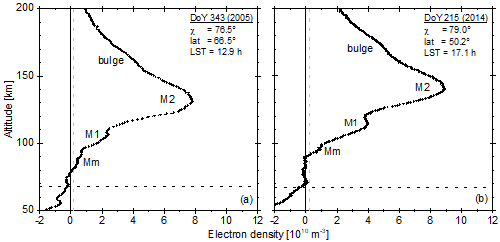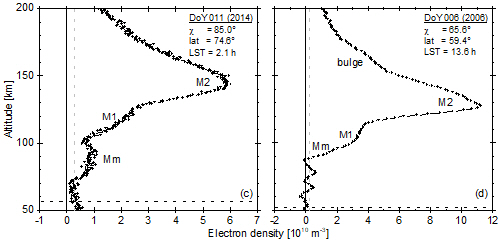- 1University of Cologne, Rhenish Institute for Environmental Research, Department for Planetary Research, Cologne, Germany (peterk@uni-koeln.de)
- 2Universidad de Murcia, Departamento de Electromagnetismo y Electrónica, Murcia, Spain
- 3Instituto de Astrofísica de Andalucía, CSIC, Granada, Spain
- 4Research and Scientific Support Department of ESA, ESTEC, Noordwijk, The Netherlands
- 5Universität der Bundeswehr München, Neubiberg, Germany
- 6Argelander Institut für Astronomie, Bonn, Germany


Figure 1: MEX-MaRS X-band observations of the dayside ionosphere of Mars for (a) Day of Year (DoY) 343 (2005) and (b) DoY 215 (2014). Combined X- and S-band (differential Doppler) observations for (c) DoY 011 (2014) and (d) DoY 006 (2006). The gray dashed line indicates the noise level, while the black dashed line marks the lowest valid altitude of the individual observation (details about the parameter derivation in [2]).
The Mars Express Radio Science experiment (MaRS) on board the Mars Express spacecraft has observed the Mars atmosphere and ionosphere since 2004. More than 900 high-resolution MaRS height profiles of the ionospheric electron density from the topside down to the ionospheric base are available.
The two dominant features of the undisturbed Martian dayside ionosphere are the main peak (M2), caused mainly by solar radiation in the Extreme Ultraviolet, and the secondary layer (M1), mostly formed by primary and secondary impact ionization of short solar X-rays < 10 nm [1]. The region below the M1 peak is highly variable and regularly contains merged excess electron density regions (Mm) in various shapes [2] (Figures 1).
More than 15 years of MaRS radio science observations are used to study the behavior of the lowest region of the Martian dayside ionosphere. Categories for the identified Mm shapes are defined and statistics of the individual Mm shape occurrences are provided. The 1-D photochemical model IonA-2 (Ionization in Atmospheres 2 [2]) is applied to investigate which of the identified Mm shapes can be reproduced by solar radiation of the quiet Sun and under solar M- and X-flare conditions.
References
[1] Fox J. L. et al. (1996), Adv. Space Res., 17, 11, 203-218.
[2] Peter K. (2018), PhD Dissertation, https://kups.ub.uni-koeln.de/8110/.
How to cite: Peter, K., Pätzold, M., Molina-Cuberos, G., González-Galindo, F., Witasse, O., Tellmann, S., Häusler, B., and Bird, M.: The lower dayside ionosphere of Mars in light of MEX MaRS radio science observations, Europlanet Science Congress 2020, online, 21 Sep–9 Oct 2020, EPSC2020-528, https://doi.org/10.5194/epsc2020-528, 2020.

